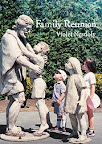
Title: Washington's Lady
Author: Nancy Moser
Publisher: Bethany House, June 2008, Paperback, 416 pages
ISBN-10: 0764205005
ISBN-13: 978-0764205002
As a non-American, I eyed my review copy of the 400-page Washington’s Lady with a little apprehension. How was I going to stomach a tome about America’s first first-lady – someone I’d certainly had no interest in till now? I needn’t have worried. For in author Nancy Moser’s capable hands, I soon began to care about what happened to the grief-stricken, yet high-spirited widow Martha Dandridge Custis. And my fascination lasted to the end. The story begins just after Martha’s first husband dies. It covers all of George and Martha Washington’s lives together, ending with Martha’s death in 1802, two years after George died.
The book’s 18 chapters are organized into three main sections. “The Golden Years” (Chapters 1-8) tells of George and Martha’s courtship and early marriage. “Our Glorious Cause” (Chapters 9-15) gives us the growing revelation of what the colonies’ resistance to Britain will mean to the country and to the Washingtons in particular. We see firsthand the grim conditions on the battlefield and come to appreciate the sacrifices many made for freedom. “The Course of Duty” (Chapters 17 -18) takes us to the end of the war and shows the pressures on George and Martha as George agrees to become the first American president while remaining responsible for a large and needy family. Though writing around a plot that has been largely determined by real life must be tricky for a fiction writer, I felt Moser did a good job of weaving an interesting character-centered story using the plot cards history dealt her and adding a few of her own where the record was mute.
The way Moser weaves that story is by creating many short scenes. Each chapter consists of a multitude of vignettes of varying lengths told in first person by Martha. In this way we get a well-rounded view of this plump, determined, optimistic, warm woman, who is also generous, unpretentious, hospitable, industrious, a smothering mother, doting grandmother, and an unendingly devoted wife. The other main character, George, is seen through Martha’s eyes and Moser manages to preserve our sympathy and respect for him, even when viewed at such close range.
There are a host of secondary characters and I did, from time to time, find myself puzzling over who was who. A family tree or some sort of chart illustrating the relationships between characters would have been helpful.
And while we’re on wishes – a little more information about dates (noted at the beginning of each chapter and within the chapters especially when there are time lapses in the action, for example) would have been nice too. I sometimes found myself confused about how much time had elapsed from scene to scene and wondering what year we were in.
Moser’s writing style is brisk and as no-nonsense as Martha, into whose skin she manages to climb with the adroitness of an actress. I liked the signature way she ends most scenes with a short, punchy statement, as one imagines Martha would have: “But I didn’t"; "Another promise to be fulfilled"; "I would not allow it"; "We would see.”
Many themes run through the book. The fear of death, especially the death of family members and children, occupies Martha a lot. Martha is a devout Christian who takes her relationship with God seriously. Thus it’s no surprise that she struggles with feelings of betrayal during times of personal tragedy – which are many. Parenting is another subject that keeps reappearing as Martha struggles with being too lenient with her son and letting George, his stepfather, be a real dad to the boy. The marriage relationship is another theme that pervades the book. We witness how George and Martha ride out the storms that family living, war, and public office bring.
Finally, the book is about character. In our time of self-indulgence, it seems odd to see people sacrifice private and family life with the integrity, selflessness, and sense of duty that Martha and George Washington serve America in its infancy.
Other goodies in the book include a section called "Fact or Fiction," where Moser explains what is fact and what fiction in the book. Besides shedding light on the historical truth of the story, her exposé gives insight into the extensive research required to write such a story. The volume ends with a set of 18 discussion questions - making the book an excellent choice for reading groups.
Washington's Lady will appeal to the reader who is a student of American history and people. Though it may lack the compelling magnetism of a page-turner, I truly enjoyed my brief sojourn with Moser’s warm and human Martha Washington. By the end, I wished I could hostess a party for her, where, as I poured her tea, I would tell her how much I admired her for the person she was and the great job she had done.
(Note: This is book three of Moser's "Ladies of History" series -- all fictional biographies. If you enjoy such books, you'll want to check out the other books in the series, Mozart's Sister, the story of Nannerl Mozart, and Just Jane, the story of Jane Austen.)
Saturday, July 26, 2008
book review: Washington's Lady by Nancy Moser
Posted by
Violet N.
at
7:59 AM
![]()
![]()
Labels: biography, book reviews, Christian fiction, historical fiction
Subscribe to:
Post Comments (Atom)

0 comments:
Post a Comment